Ponds and natural pools for a chemical-free bath
TRAINING
Get trained in biological swimming pools with our online course in natural swimming pools.
ACQUIRE OR INSTALL A BIOPOOL
Whether it’s a new pool or transforming the one you already have, we can advise you on all option
DESIGNING AND INTEGRATING A BIO-POOL OR POND INTO A PROJECT
If you are a designer or architect and you are looking for technical features.
Biopools: types, benefits and everything you need to know to have a natural and ecological pool.
If you prefer, you can click directly on the part that interests you:
- Do you know the water where you and your family bathe?
- Water quality parameters
- What is a natural swimming pool, bio-pool or biological swimming pool?
- Examples of natural swimming pools or bio-pools
- Benefits of a natural swimming pool or bioswimming pool
- What you need to install a naturalised pool
- Design criteria for a natural swimming pool
- Integration possibilities for bio-pools
- Maintenance of biological pools
- Frequently asked questions
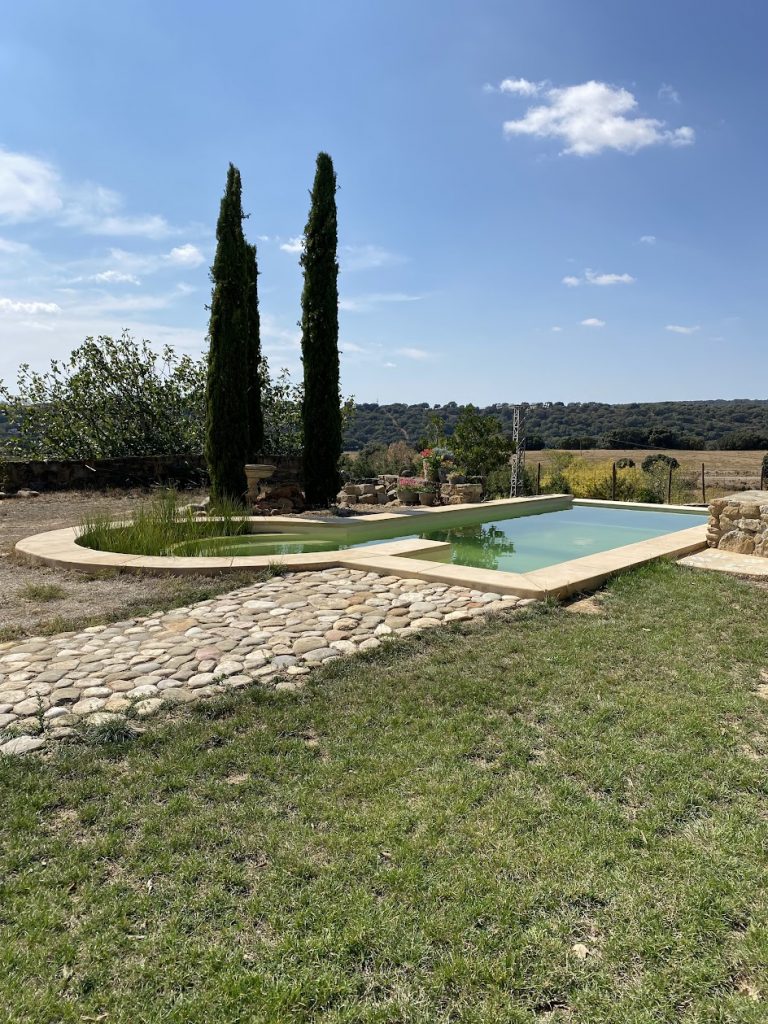
So the water where you and your family bathe?
We all like to bathe in clean, crystal clear water, and this has led to the development of water purification methods to keep stagnant pool water clear.
But are you aware of the problems caused by chemical treatments?
The use of chemical products, mainly chlorine, causes a number of problems.
Eyes become irritated, chloramine can cause asthmatic problems, people with sensitive skin can suffer from dermatitis. In addition, the water has a chlorine smell and taste.
The reason is simple, the chemical purification products what they do is KILL the pathogens and the unicellular algae of the swimming pool (it kills them but it DOES NOT eliminate them and that is why in public swimming pools it is compulsory to renew the water every certain time).
In a natural pool or bio-pool no chemicals are used to purify the water, because the plants and biological filters are the ones that keep the water clear and crystalline because in this case they ELIMINATE the two causes that provoke the algae.
The result is similar to the water of a river, natural pond or lagoon, with all the guarantees of quality and transparency
Water quality parameters in a chlorinated pool and biological pools or why algae appear
In all pools, leaves, insects, scales from our skin fall into the water; all this organic matter degrades and generates ammonia among other compounds.
The accumulation of these compounds feeds the algae that grow and die, which generates more organic matter and nutrients in a spiral of biomass generation, this is known as eutrophication.
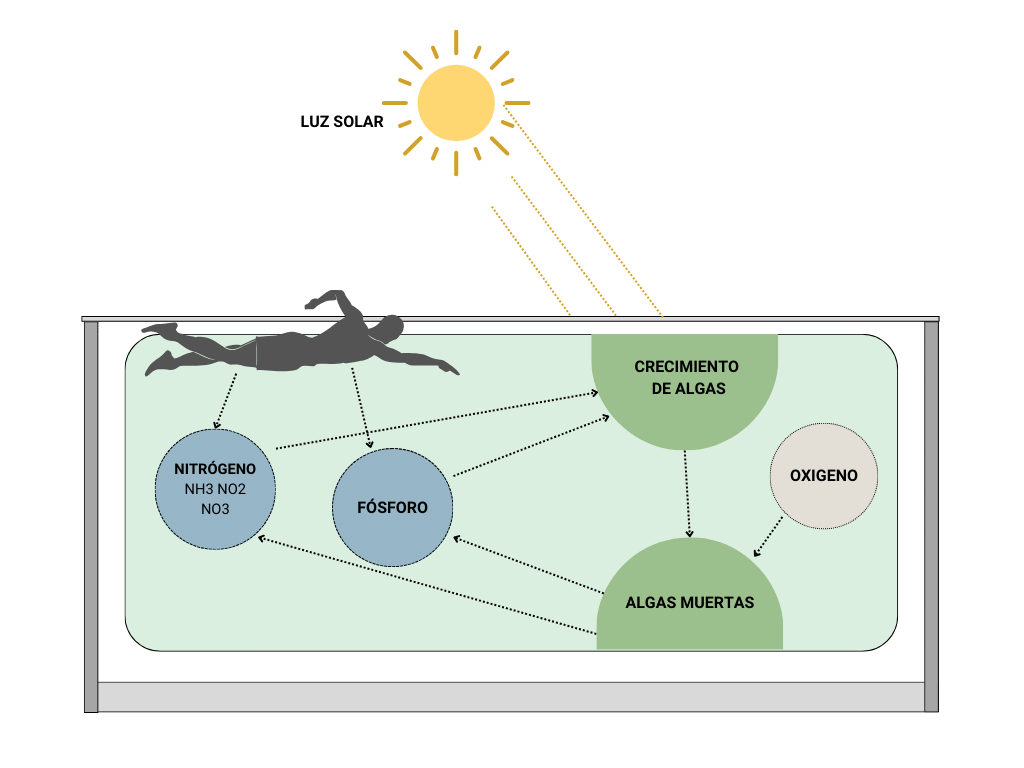
The proliferation of unicellular algae causes us to lose the first quality parameter, the transparency of the water.
Losing this transparency is not desirable, but this is not a parameter that affects our health, so we could in principle do without it.
The problem is that if eutrophication continues, pathogenic organisms (“Escherichia coli”, Pseudomonas aureoginosa” and “Legionella spp”) will appear. These are harmful to health and are the real problem.
Although each country will have its own criteria, in Spain the criteria for a swimming pool are established by Royal Decree 742/2013, and this will be our reference for the quality of the water in which we want to bathe:
Chemical-physical parameters:
- Ph limit between 6,0 and 9,0
- Transparency. Bottom drain visibility criterion.
- REDOX potential between 250 and 900mV*.
- Turbidity lower 5 UNF
Microbiological parameters:
- “Escherichia coli” 0 UFC
- “Pseudomonas aeroginosa” 0 UFC
- “Legionella sp.” 0 UFC
*REDOX is a quick and inexpensive way to find out the disinfecting power of oxidising biocides. Biocidal products are mixtures containing one or more active substances that serve to repel, neutralise or destroy harmful organisms.
These biocidal active substances can be chemical substances or micro-organisms.
The solution to this problem is the creation of a balanced ecosystem in which plants have an easier time absorbing nutrients and prevent algae proliferation.
We do this by transforming these nutrients through the construction of the biological filter.
Esto lo hacemos transformando estos nutrientes mediante la construcción del filtro biológico.
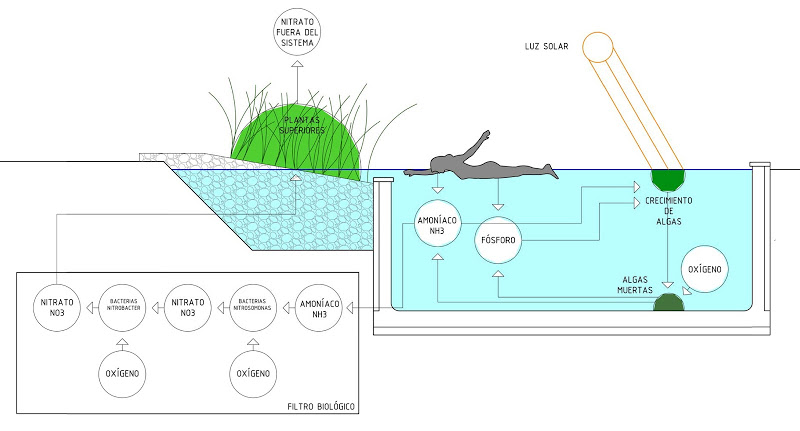
The suspended organic material in the pool water generates ammonia NH3. Ammonia is a nutrient for algae but not for higher plants and is toxic for fish and humans.
A biological filter transforms ammonia NH3 into nitrate, NO3, by adding oxygen.
The nitrate is perfectly assimilated by the higher plants, which absorb it and remove it from the system so that it is not available to the algae.
Natural ponds and pools for chemical-free bathing
Bathe in water treated only by biological and mechanical means and get MORE than a unique experience.
The main quality indicator to consider in a natural or naturalised pool is the transparency of the water.
To avoid any problem compromising transparency, it is essential to carry out pruning to remove organic matter and cut the spiral of biomass generation.
A natural swimming pool (also known as an ecological swimming pool or bio-pool) is one in which purification is achieved in a natural way, without the use of chlorine or any other chemical product to purify the water.
It is achieved with the installation of a biological filter of aquatic plants, which through their phyto-purification action, keep the water clear and the quality parameters ideal for bathing.
This is a relatively new concept, so there is no global consensus on the subject. It is common to find cases in which natural pools are mistakenly called those that have a more organic aesthetic or a better landscape integration, although they are purified by chlorine or saline chlorination.
From SingularGreen we promote the installation of natural pools within the standards set by the Iberian Association of Naturalised Bathing Waters.

It defines a natural pool as any pool that promotes the growth of certain biodiversity in order to obtain a controlled ecosystem. It therefore excludes the use of ultraviolet filters, ultrasound, copper ion purification or any other system designed to suppress part of the biodiversity.
What are ecological or naturalised swimming pools?
At SingularGreen we offer our services of design and installation of natural swimming pools and we make tailor-made solutions according to your needs and those of the ecosystem of the place.
Examples of naturalised pools or biopools
Benefits of a natural pool or biopool
Una piscina natural supone una clara evolución frente a las convencionales, aportando múltiples beneficios, tanto para nuestra salud como para el medio ambiente:
Water and energy savings
The water does not need to be renewed periodically and a low-consumption pumping system is used. This translates into economic savings.
Health care
Unlike chlorine purification, natural pools do not use chemicals, which are harmful to our health.
Reduced maintenance
It reduces maintenance time and costs, as tasks are limited to periodic surface cleaning and a few annual tasks.
Greater landscape integration
It allows an appearance closer to natural spaces. It is also comparable to the aesthetics of contemporary swimming pools.
Promoting biodiversity
A diverse and balanced ecosystem is created, both in the pool and in the surrounding area..
There is another class of benefits that have to do with the emotions and the experience of bathing in a natural pool.
Bathing in chlorine-free water causes a feeling of well-being similar to the one you have when diving into a clear-water river.
In some cases, it becomes a necessity for those who have atopic skin, allergy problems, or who have simply decided to become aware of caring for the environment and the responsible use of water.
En algunos casos, llega a convertirse en una necesidad para aquellos que tienen piel atópica, problemas de alergias, o que simplemente han decidido concienciarse con el cuidado del medioambiente y el uso responsable del agua.
Possibilities for the integration of natural pools
When designing a natural pool project, we must bear in mind that it will consist of two parts: the swimming area and the regeneration area (where the biological filter of aquatic plants is usually located).
Depending on how these two areas are distributed and related, there will be different pool configurations:
Separate vessels
Swimming ponds
Mixed solutions
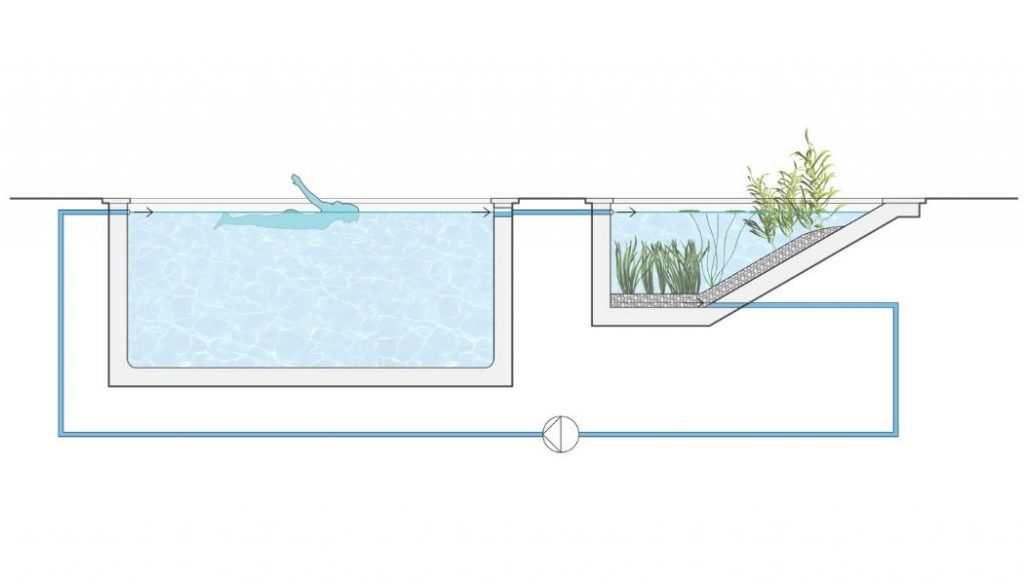
The swimming space and the biological filter are built in two different vessels. It is important to ensure efficient pumping and movement of water from one vessel to the other.
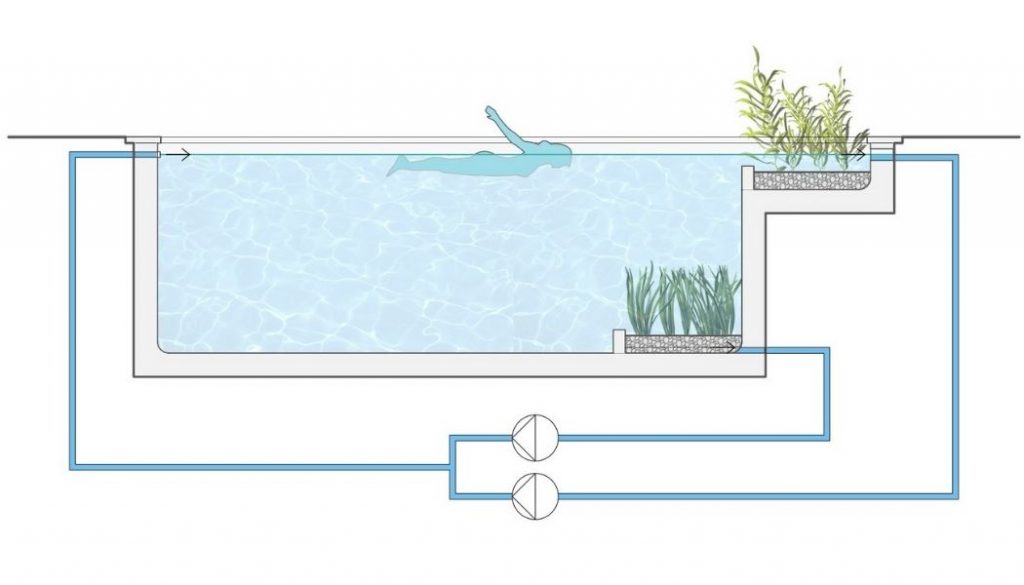
The swimming area, the regeneration area and the biological filter are arranged in the same space. It is very efficient as the bathing water is in direct contact with the filter and the plants.
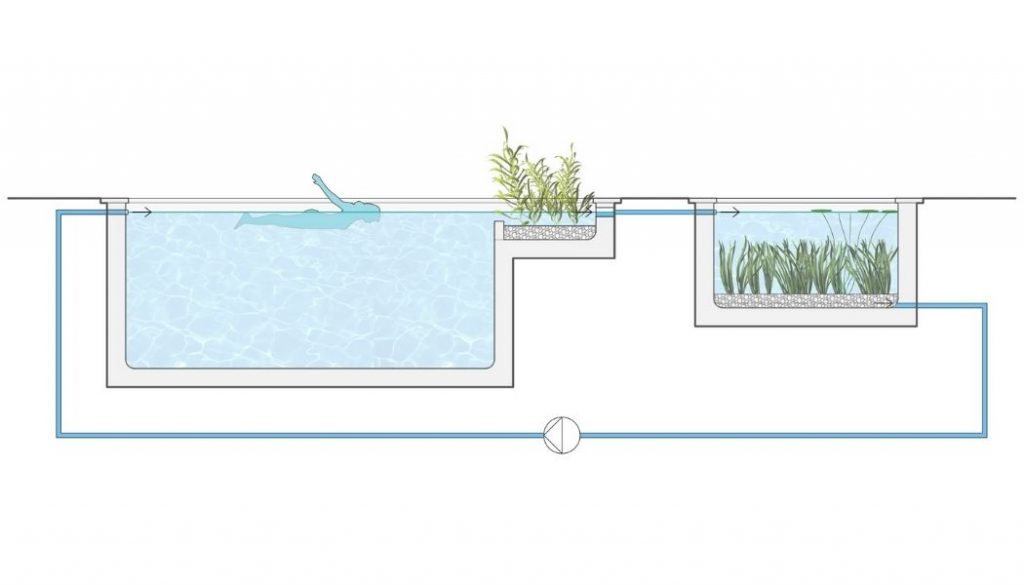
This is a combination of the two previous options. The options are multiple and depend on the premises of each project.
Design criteria for a natural swimming pool
In the construction of a natural swimming pool we distinguish between two parts: the construction of the pool shell, i.e. the structure of the pool, and the installation of the natural purification system.
In order to size and design the purification system, three aspects must be considered:
The climate
A direct way of selecting plants, and it is always advisable to use indigenous species.
The location
From knowing the direction of the prevailing winds to the weather and the degree of sunshine that the pool will receive, in order to select the species.
Water quality
The amount of nutrients, especially phosphates, that are brought in by the filling water is decisive for the dimensioning of the biological filter.
Además, para el diseño paisajístico del vaso se deben tener en cuenta aspectos como la profundidad, la seguridad en los accesos y la elección del sistema constructivo y los acabados.
What you need to set up your naturalised swimming pool installation
1. Study of the possibilities of integration in the plot and distribution of the bathing areas and regeneration of the natural swimming pool.
2. Analysis of the filling water and sizing of the regeneration area and biological filter, depending on the surface area and total volume of water.
3. Choice of the most suitable construction system and finishing materials for the construction of the pool.
4. Selection of species adapted to the quality and properties of the water, the climatology and the location.
5. Design of the circulation installation and the pumping system, with the complementary filters required according to the particularities of the project.
In the case of an existing pool conversion, the steps to be followed are those necessary for the design and sizing of the biological filter and its arrangement within the pool.
En el siguiente vídeo os mostramos tres ejemplos muy distintos de piscina natural
Maintenance of natural pools
The maintenance of a natural pool is simpler and less costly than that of a chlorine pool, where pH and chlorine levels have to be continuously measured.
Natural pools go through a process of eutrophication after installation, i.e. the water loses transparency as the nutrients in the water are released as organic matter.
There is no need to be alarmed, over the course of several weeks the water gradually regains its transparency, until it reaches full clarity levels.
From then on, maintenance is reduced to three tasks:
* Annual pruning of plants, to remove organic matter from the pool and encourage the healthy growth of the species.
* Surface cleaning, as in conventional pools, of both the surface and the bottom.
* Review of the components, checking especially that the pump is working.
In the following video you can see the maintenance of a natural swimming pool:
Frequently asked questions about natural pools
Añade aquí tu texto de cabecera
Currently there are several options on the market that offer natural pools. Always remember that a biopool is one that has a biological filter and aquatic plants.
The design (pond type or modern pool) will depend on the client’s taste, the budget or the surrounding environment.
The most effective and reliable way is to use the SingularBlue system, capable of adapting to all situations.
Como has podido ver en esta página, una biopiscina es ante todo la decisión sobre el sistema de depuración del agua.
Con esto queremos decirte que el precio dependerá sobretodo de otros factores: dimensiones, acabados, integración con el paisaje, si se trata de una reconversión…
Por todo esto si estás pensando en hacerte tu piscina natural, no dudes en contactar con nosotros para informarte del precio en tu caso particular.
Definitely yes.
You may have read that in order to convert a chlorinated pool into a biological filter pool, certain characteristics are necessary: minimum dimensions, a certain depth, temperature.
The SingularBlue system is totally revolutionary and eliminates all these limitations that were usually raised.
To find out more, take a look at the SingularBlue system.
Yes.
As a preliminary step, we need to analyse the water with which the pool will be filled.
In this case, you can send us the water to be analysed (we will deduct the cost of shipping from the final price) or you can carry out the analysis yourself and send us the results.
You can see how the analysis is carried out by clicking here.
Yes, it can be used if it comes from roofs.
If it comes from surface runoff, it should be filtered beforehand and an analysis should be carried out to ensure that it does not provide excessive phosphates.
If its quality is adequate, it is possible to use it, if not, other sources of water will be sought or a previous treatment will be carried out to eliminate the excess phosphates.
It could be possible, but the well water must first be tested.
If its quality is adequate, it is possible to use it, if not, other water sources should be sought or pre-treatment should be carried out to remove excess phosphorus.
fosfatos.
We love this question because aquarium pools are our favourite.
To answer this question we leave you the link to a more extensive article in which we talk more in depth about everything that has to do with having a pool with fish.
.
In our desire to spread the word about natural swimming pools we have several articles and explanatory videos; from the selection of plants for a natural swimming pool to the step-by-step installation of the SingularBlue system.
However, the SingularBlue system kit is only available to approved installers.
This way the SingularGreen guarantee can be guaranteed.
There’s no need.
Among our options, SingularBlue allows the installation of the biological filter and the vegetation on the floor of the existing pool.
The existing installation and pump do not connect to the SingularBlue system, although they can be used independently to clean the bottom and the for 15 minutes per day.
It is not necessary.
Within our options, SingularBlue allows the installation of the biological filter and vegetation on the existing pool floor.
The pre-existing installation and pump are not connected to the SingularBlue system, although they can be used independently to clean the bottom and to clean the surface of leaves and insects for 15 minutes a day.
The type of gravel is chosen according to the results of the water analysis.
The amount of gravel will also change depending on the pH and other parameters of the analysis, so its specification will depend on each situation.
